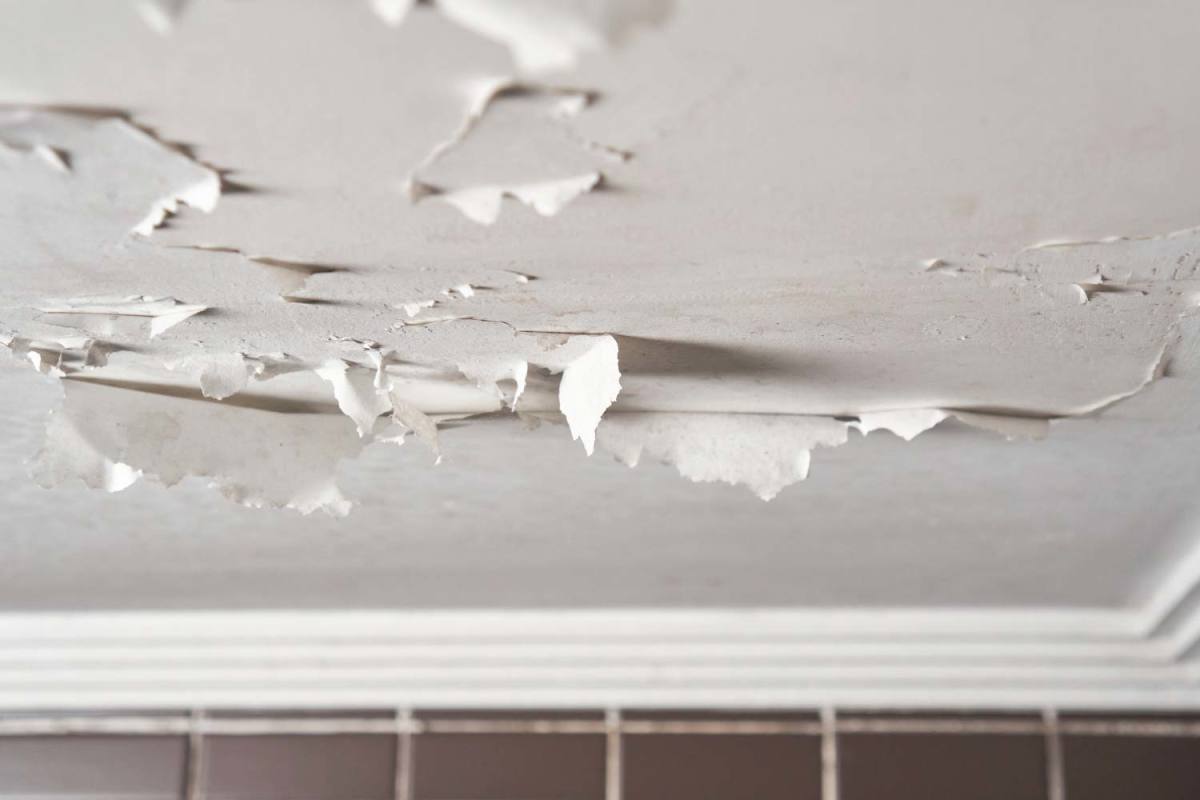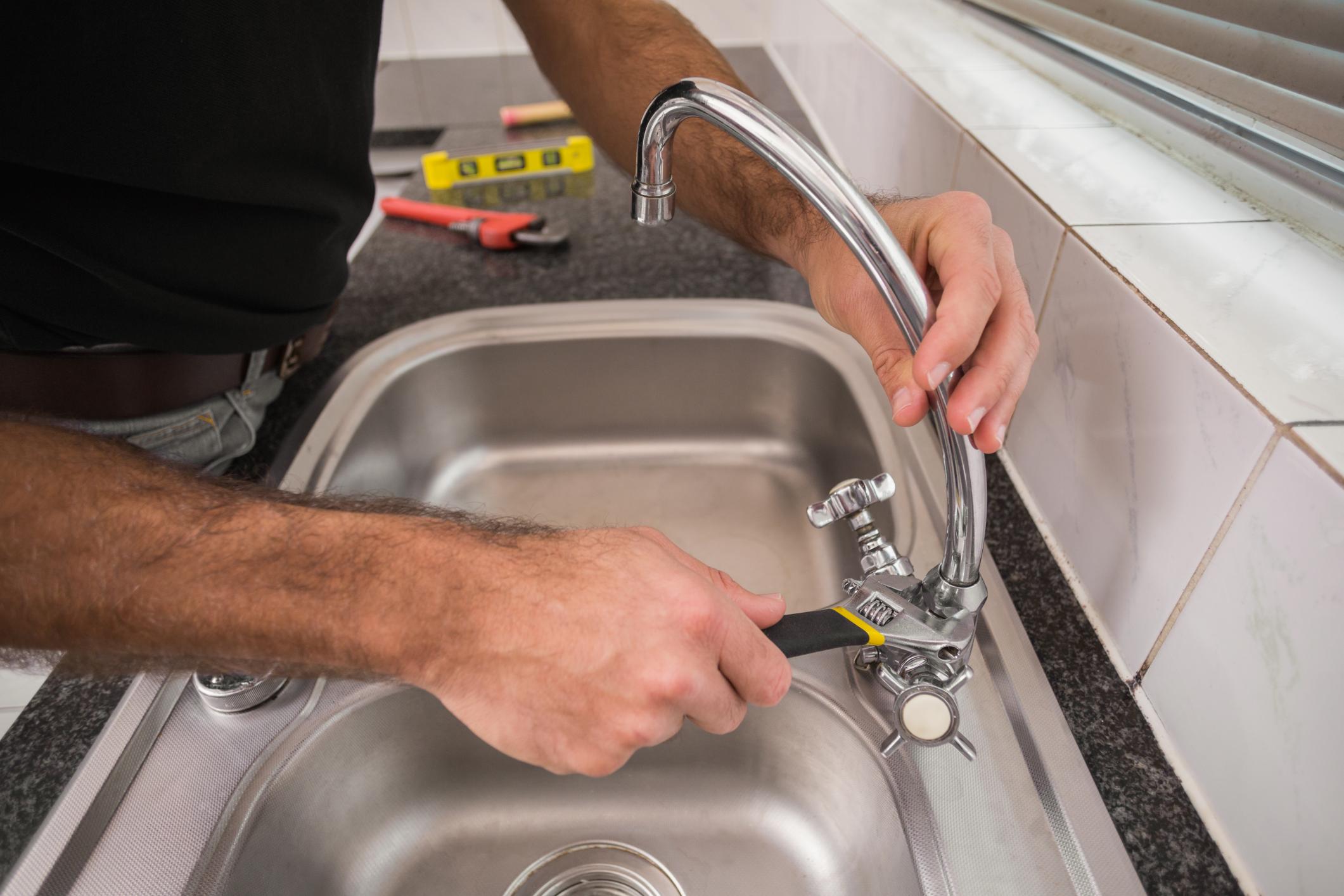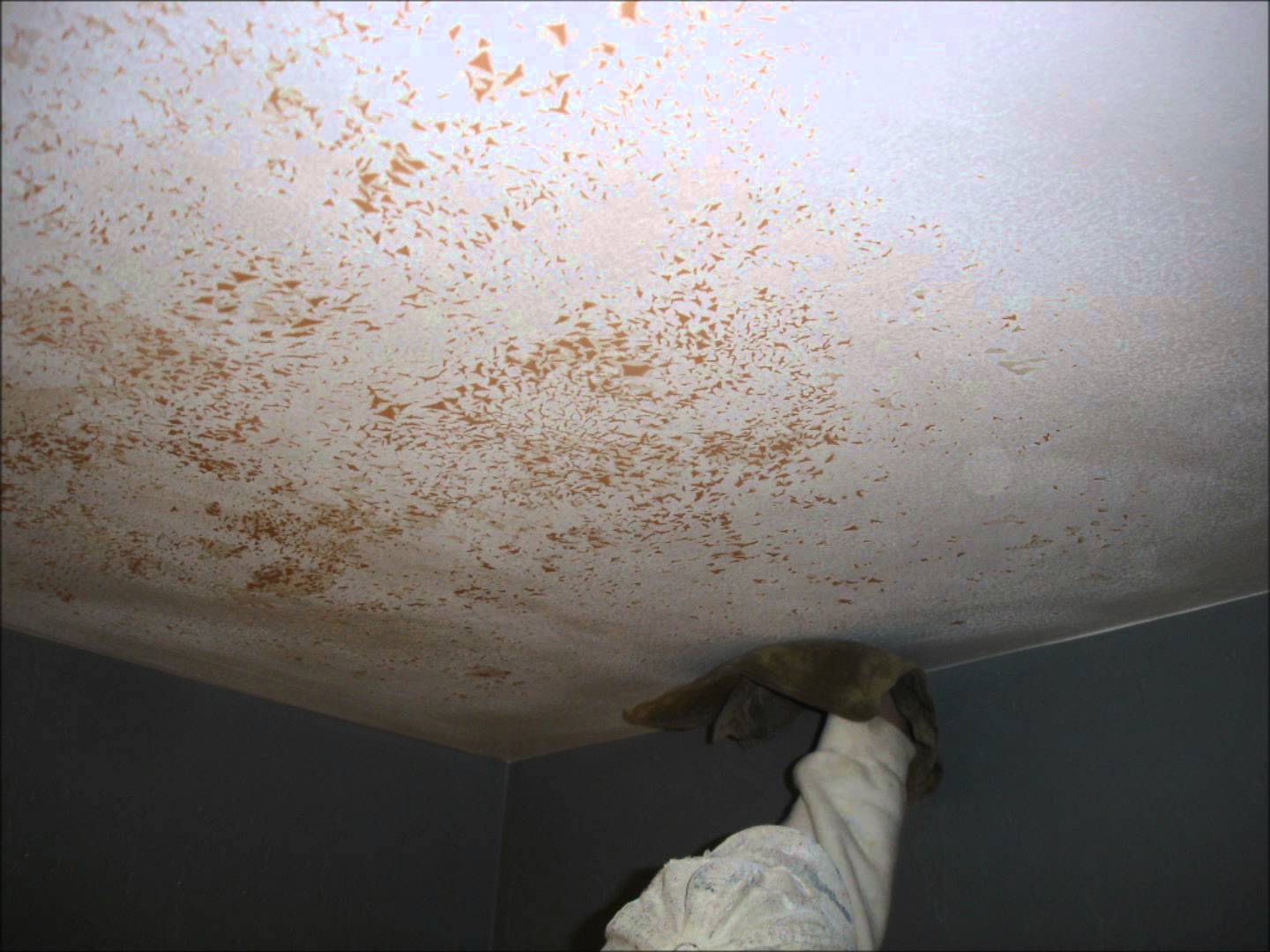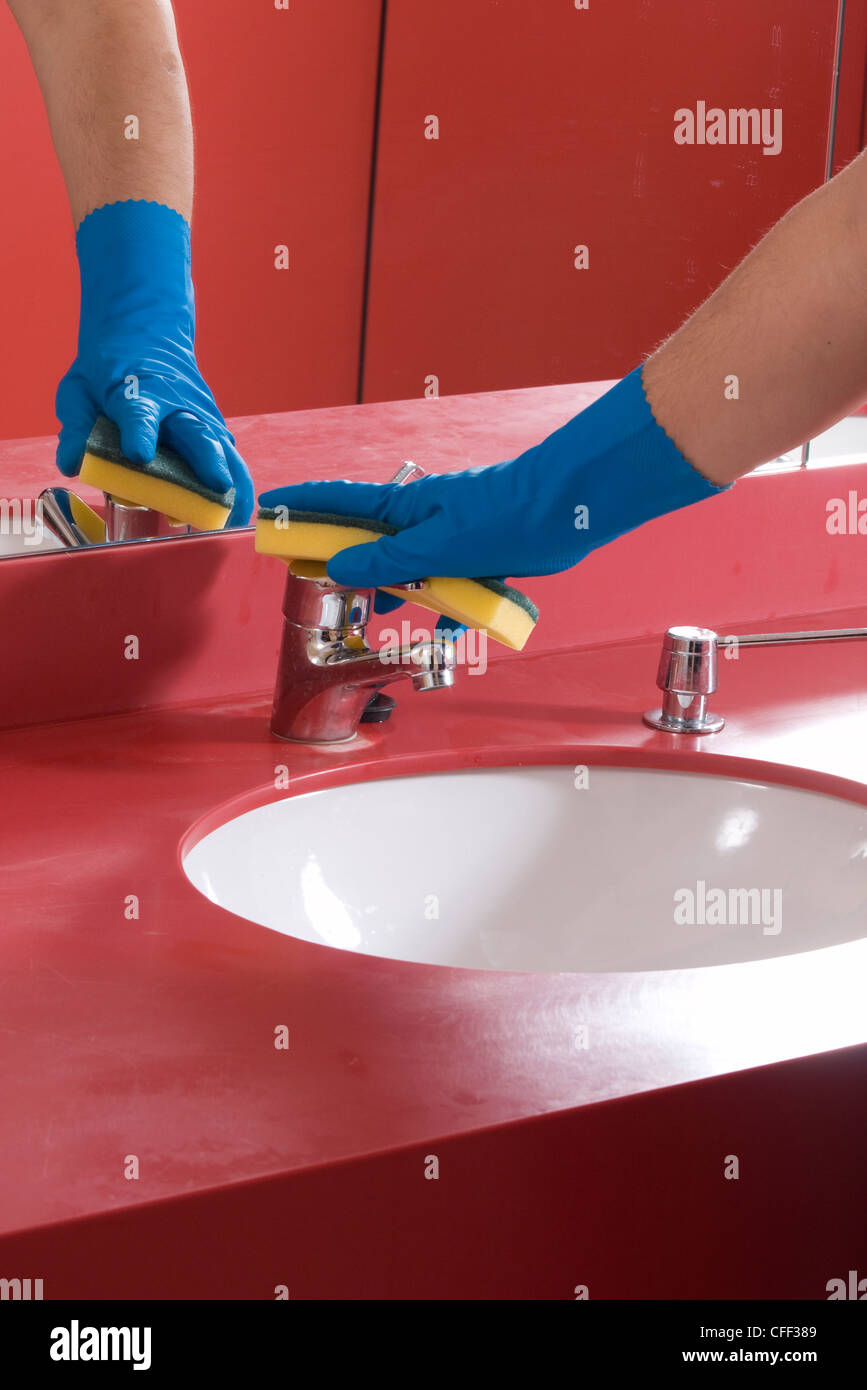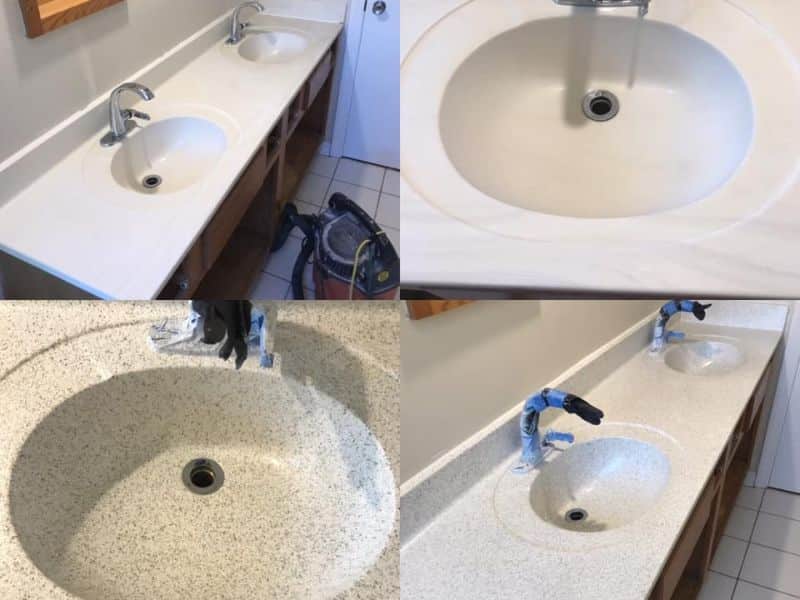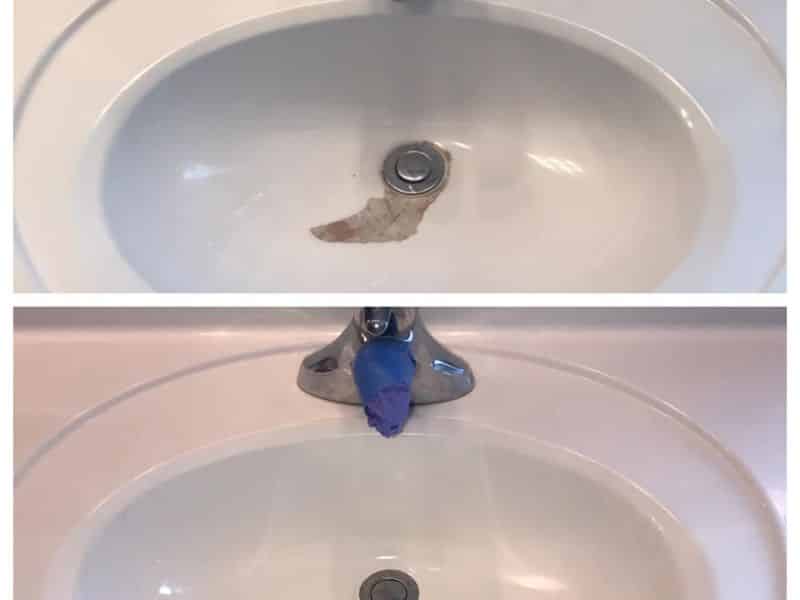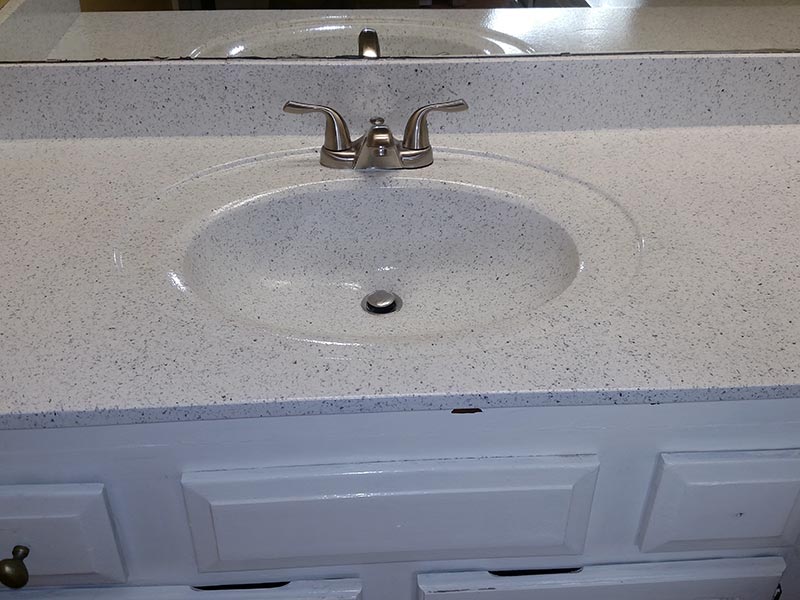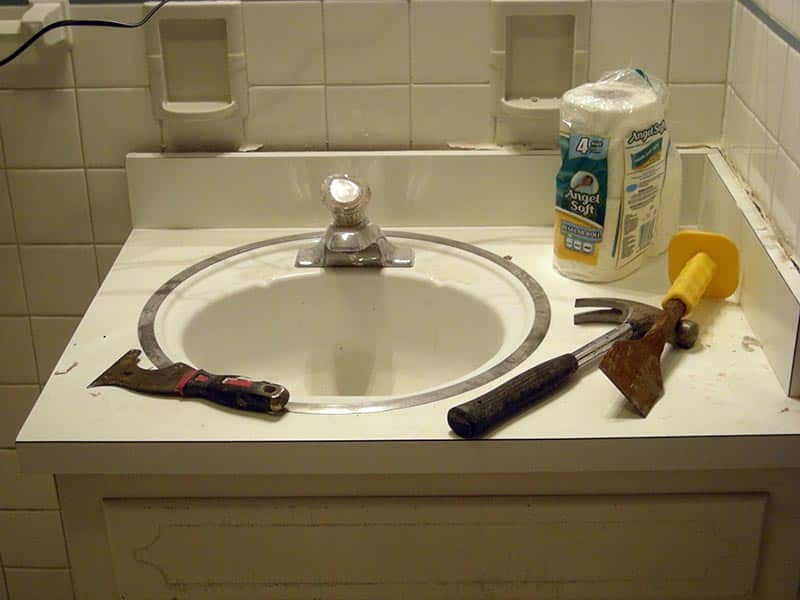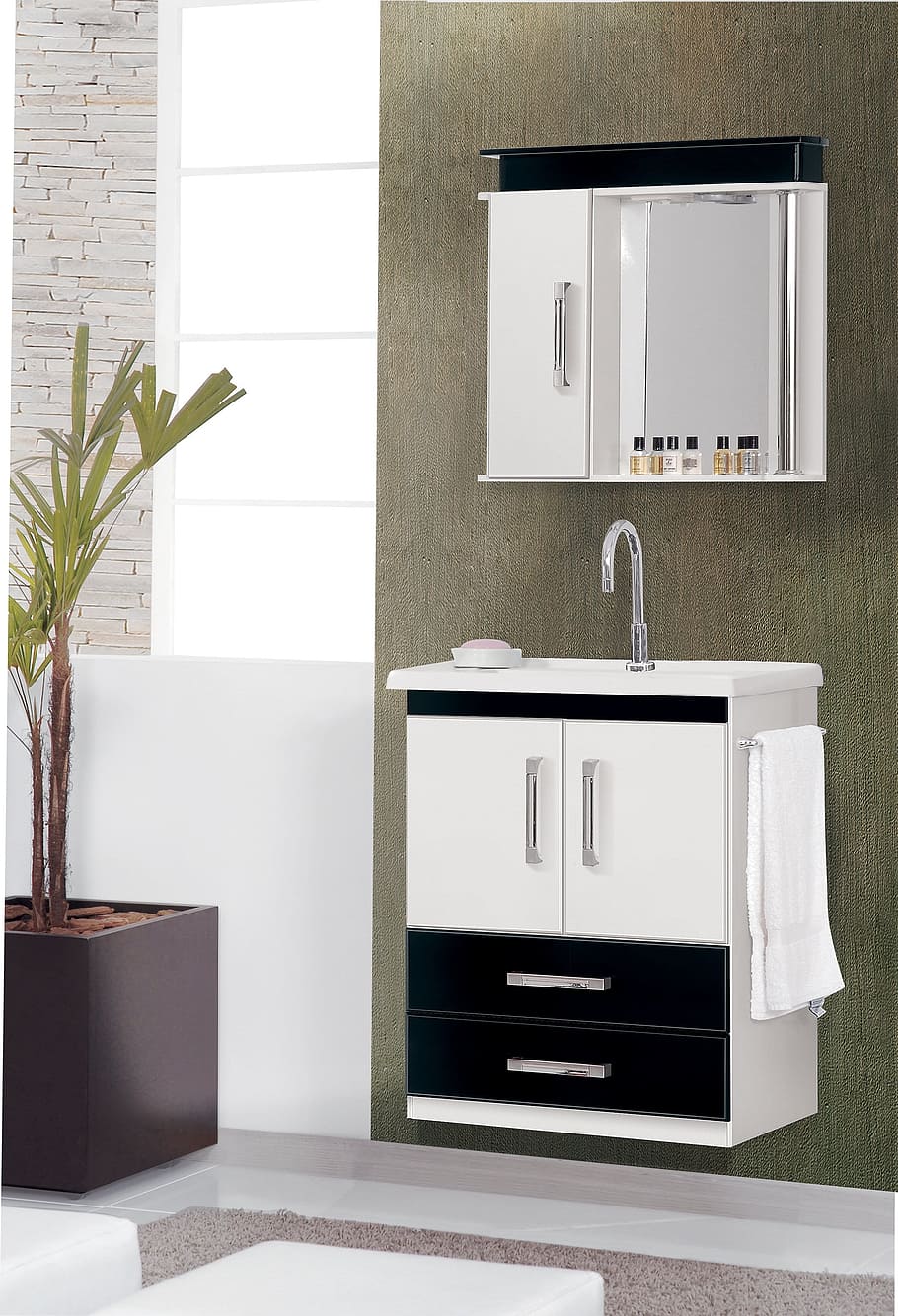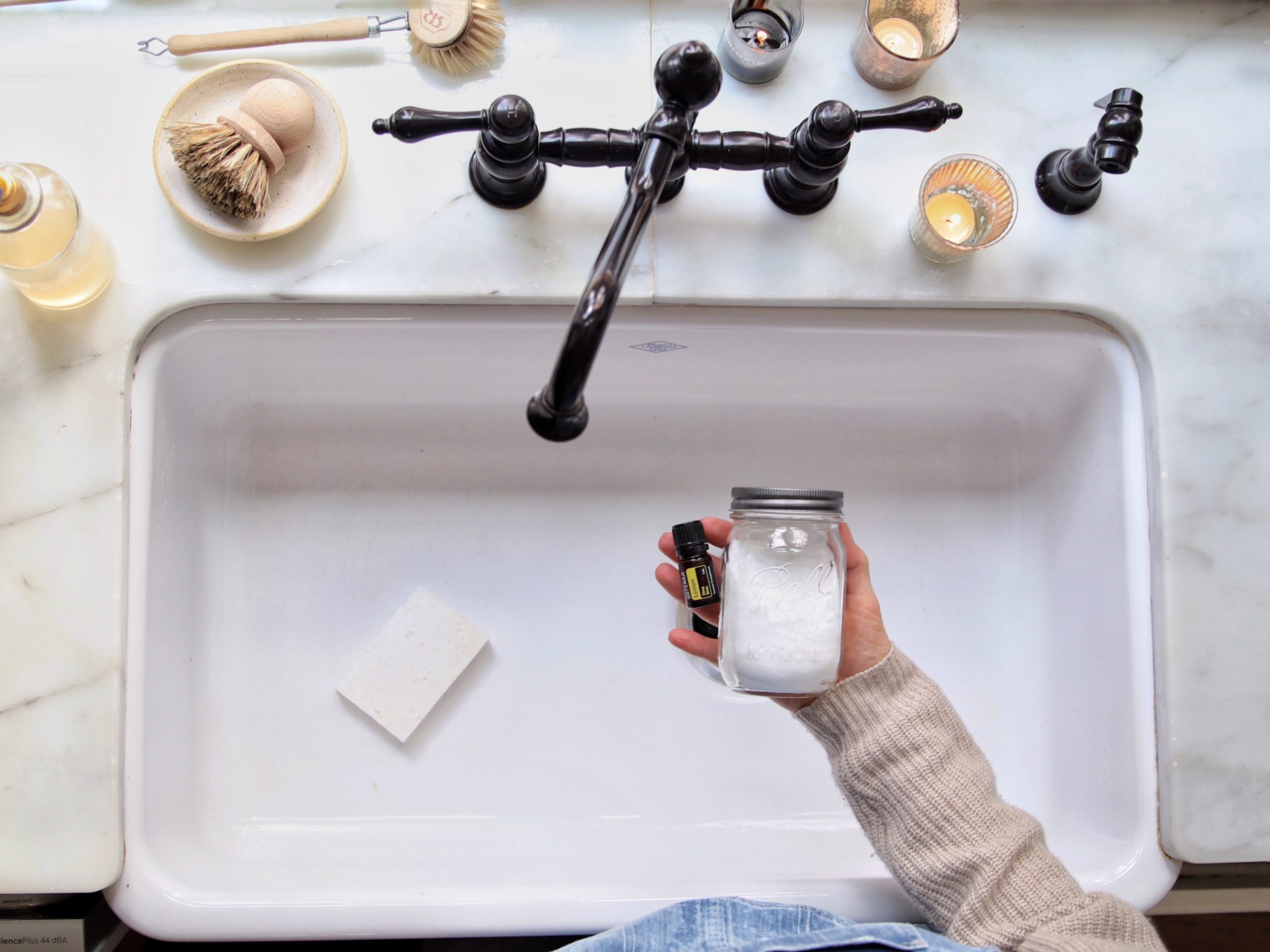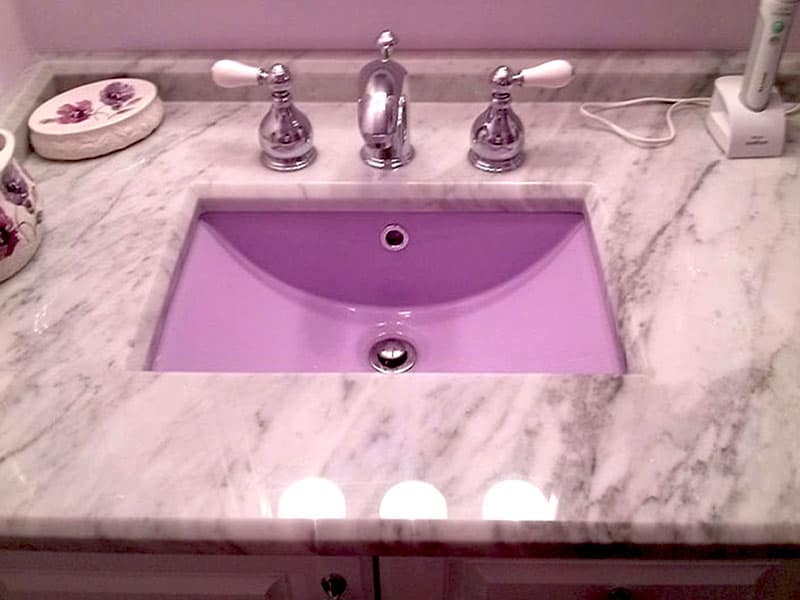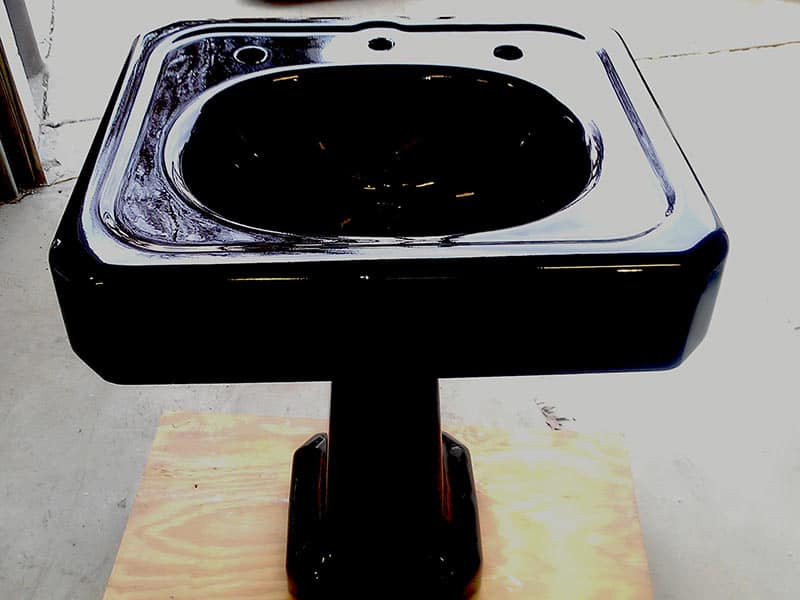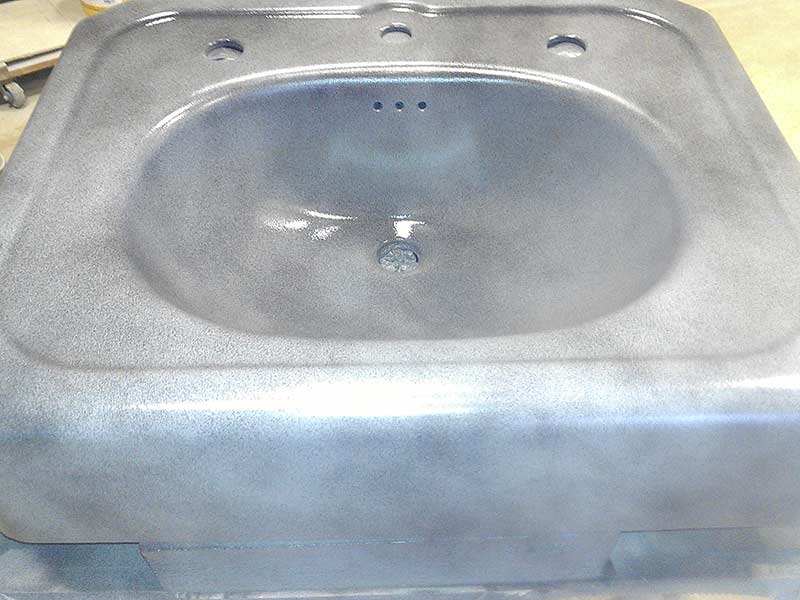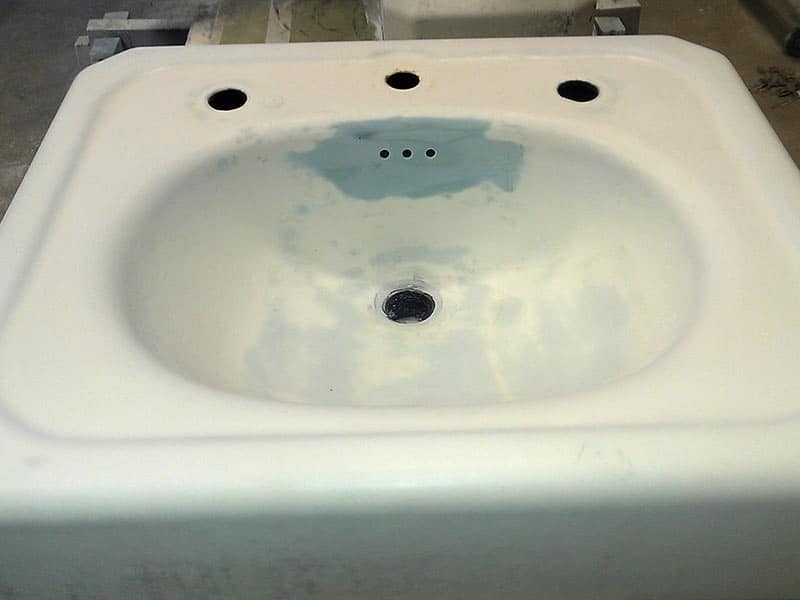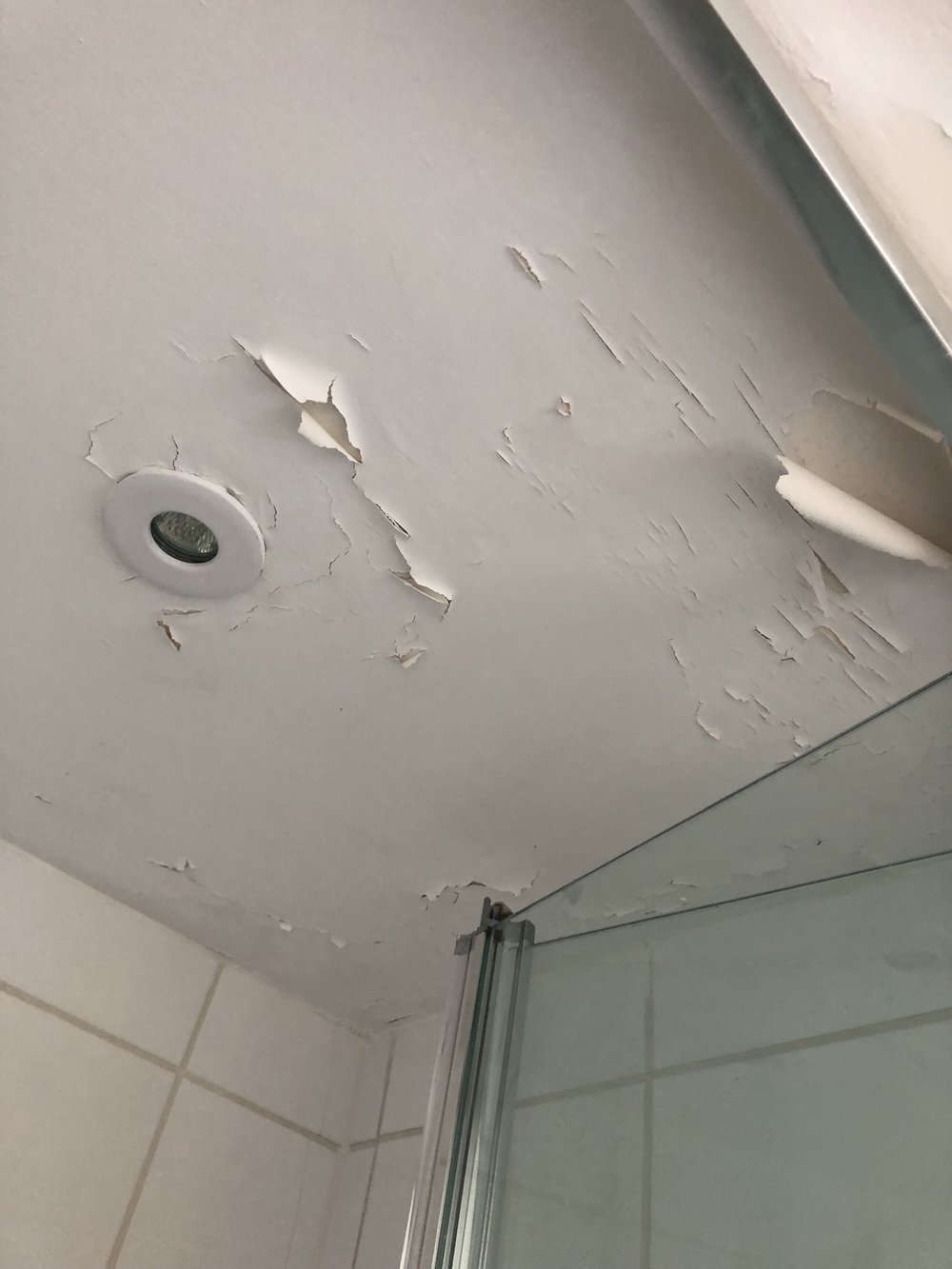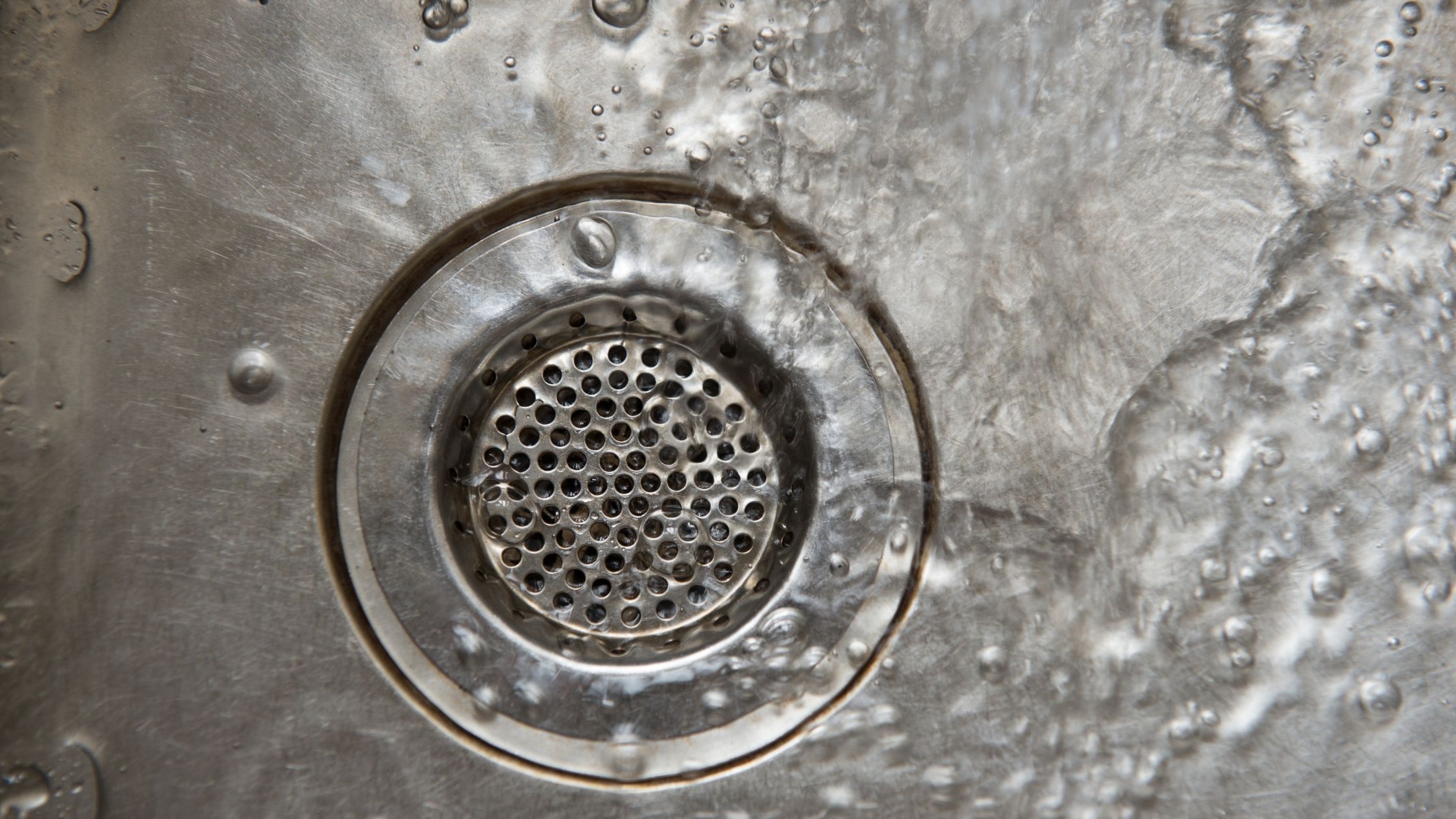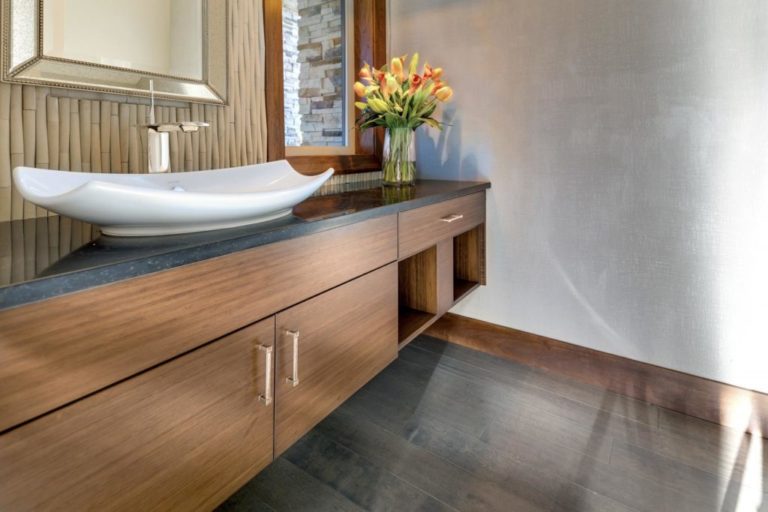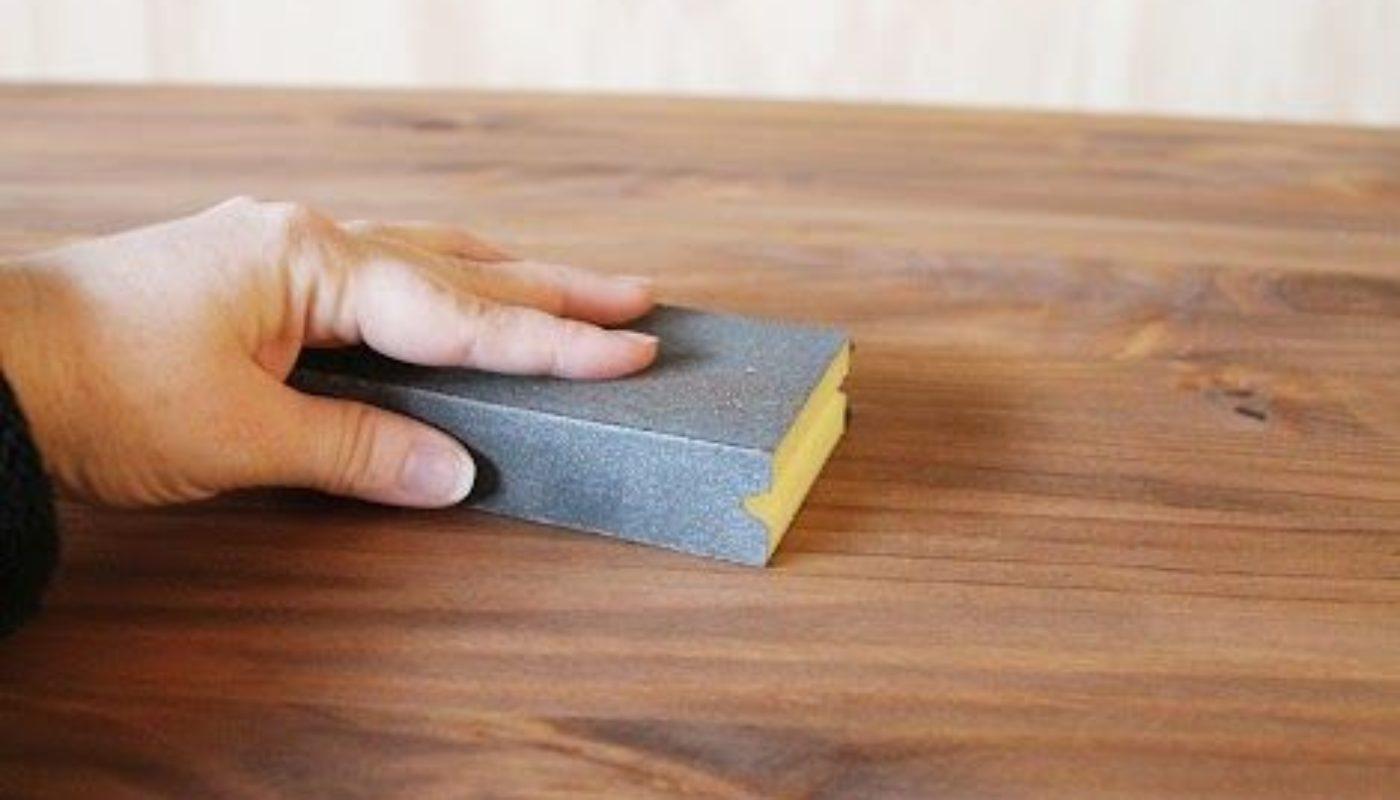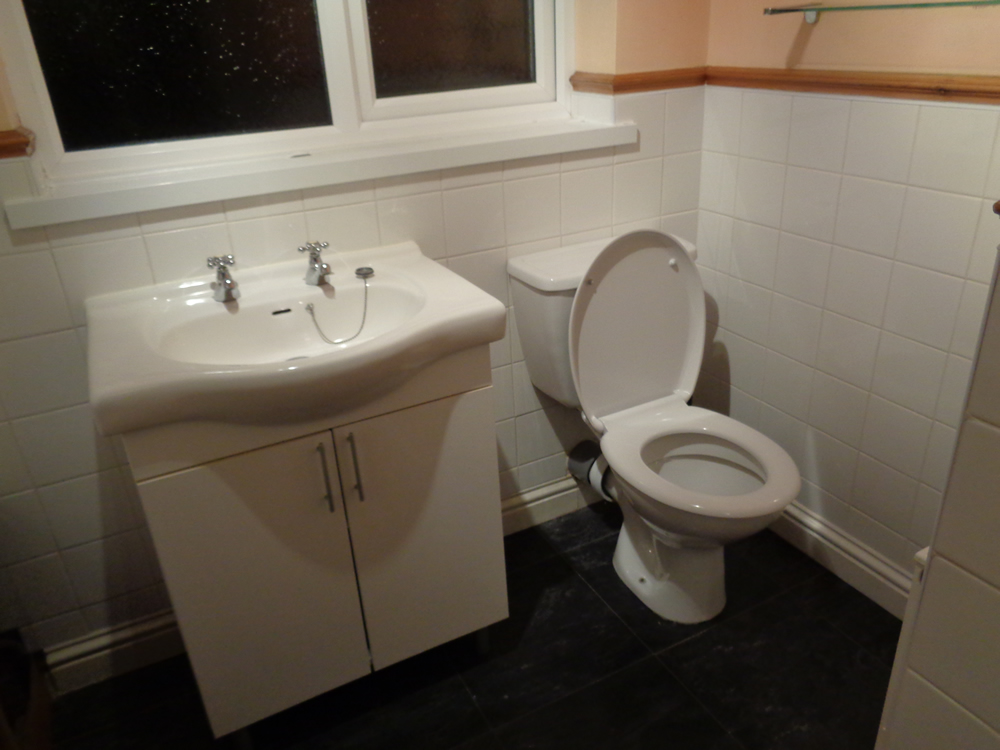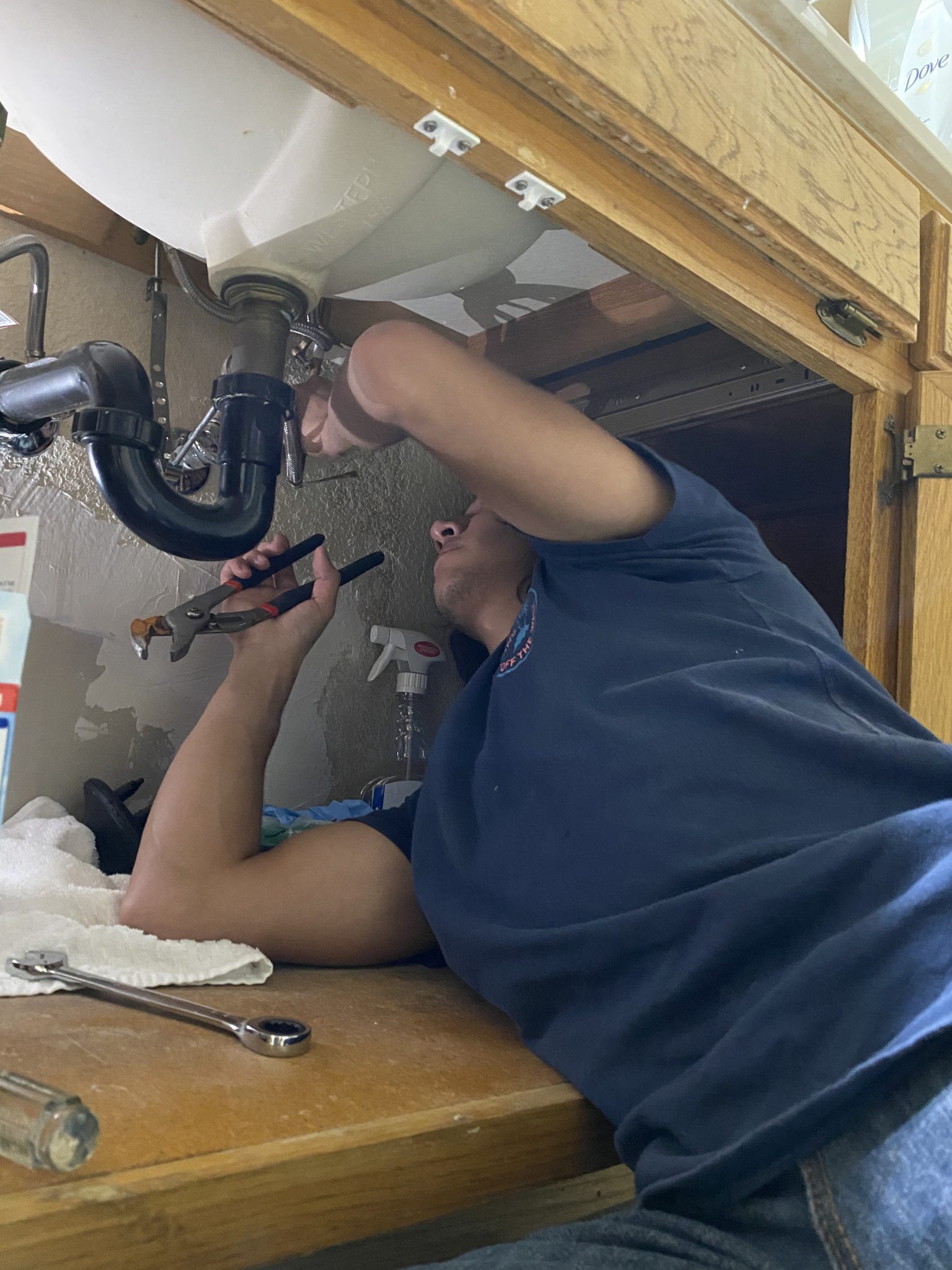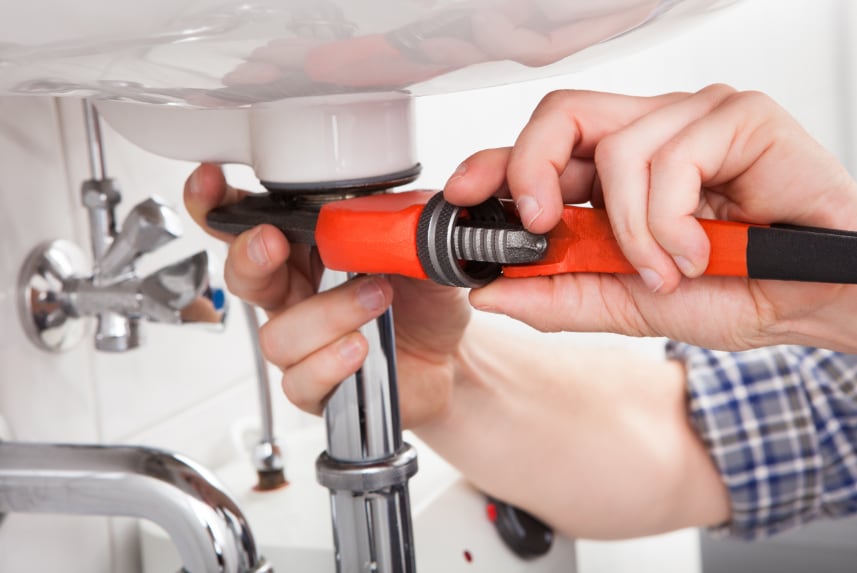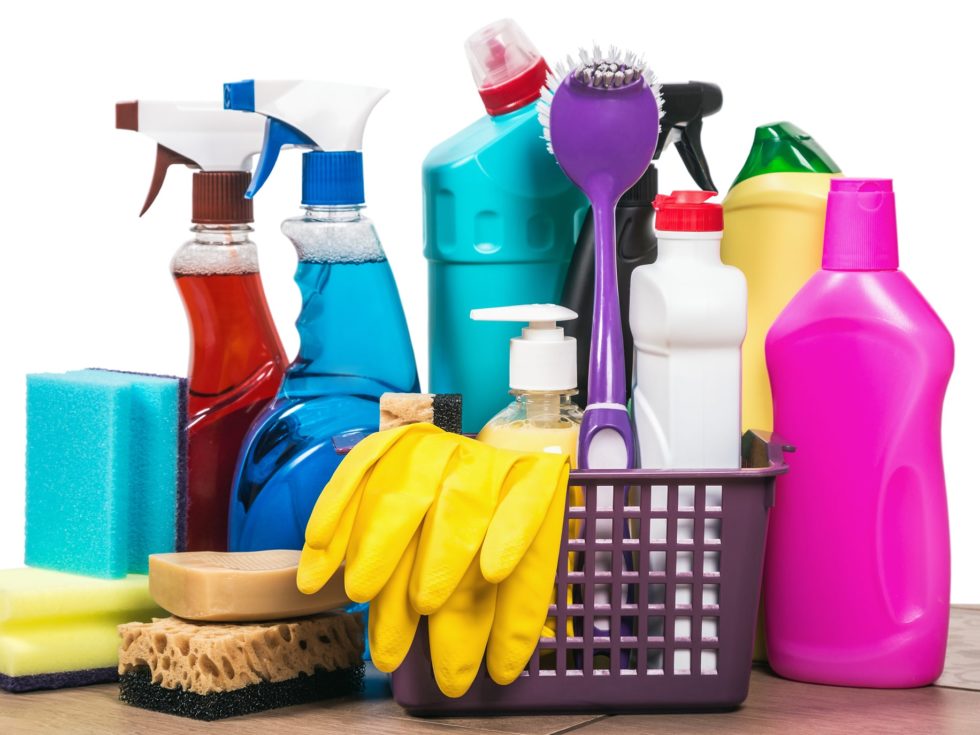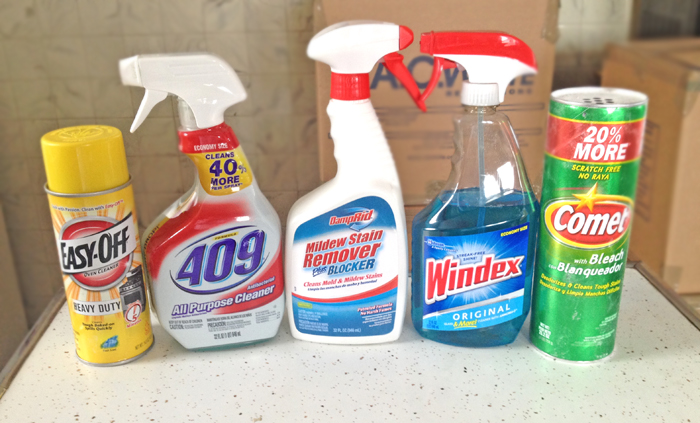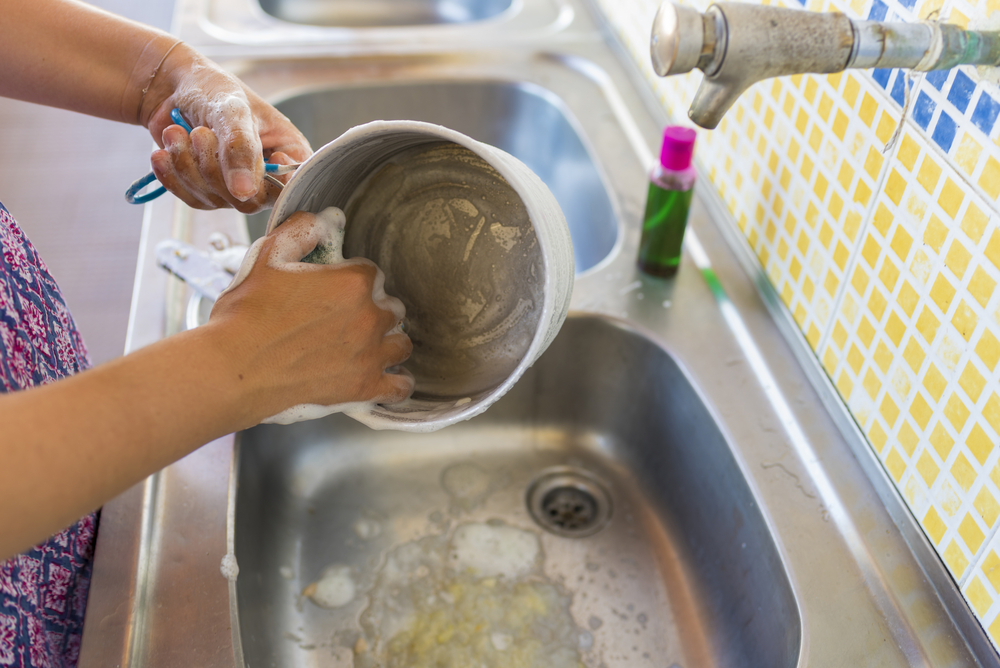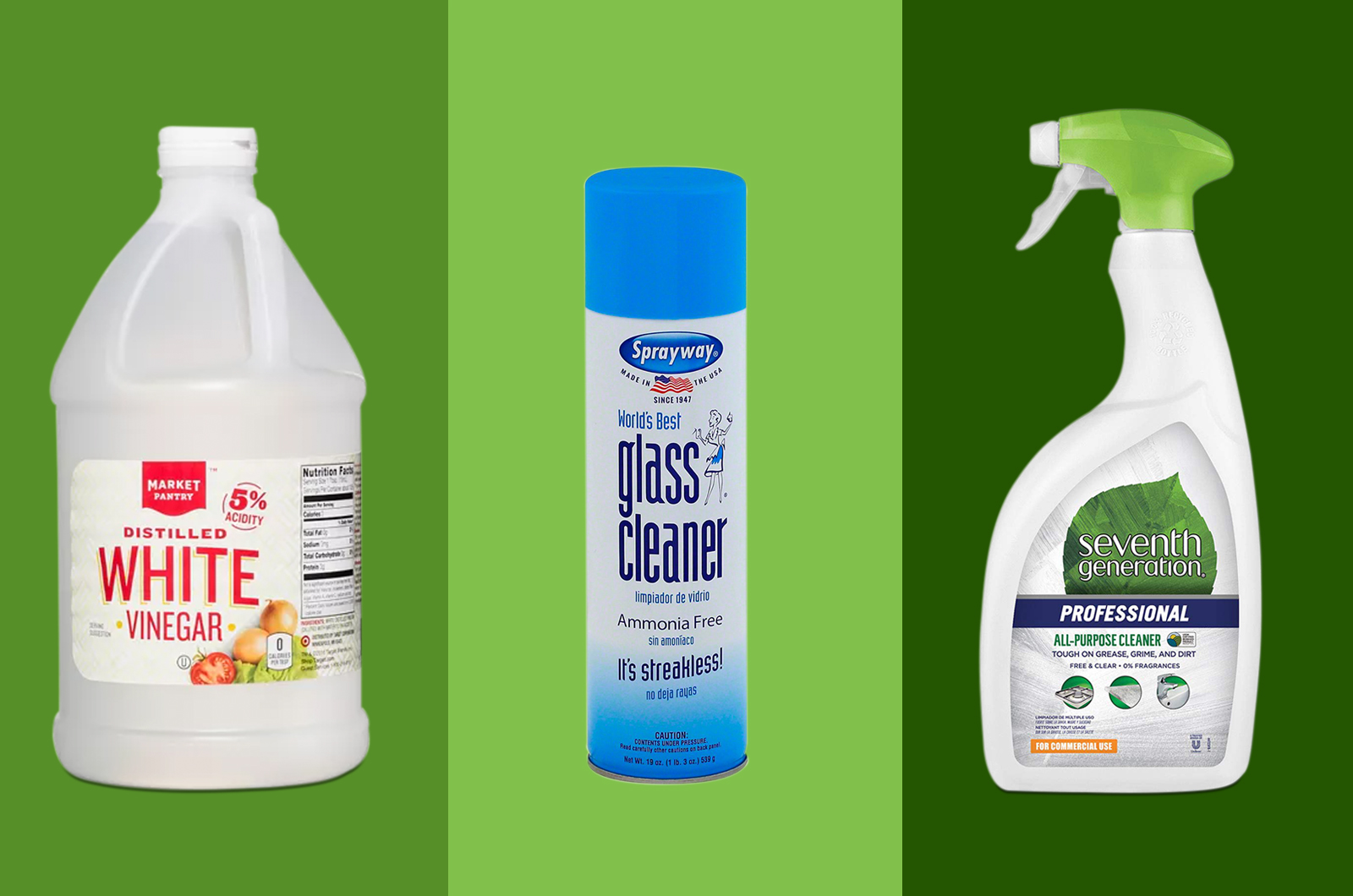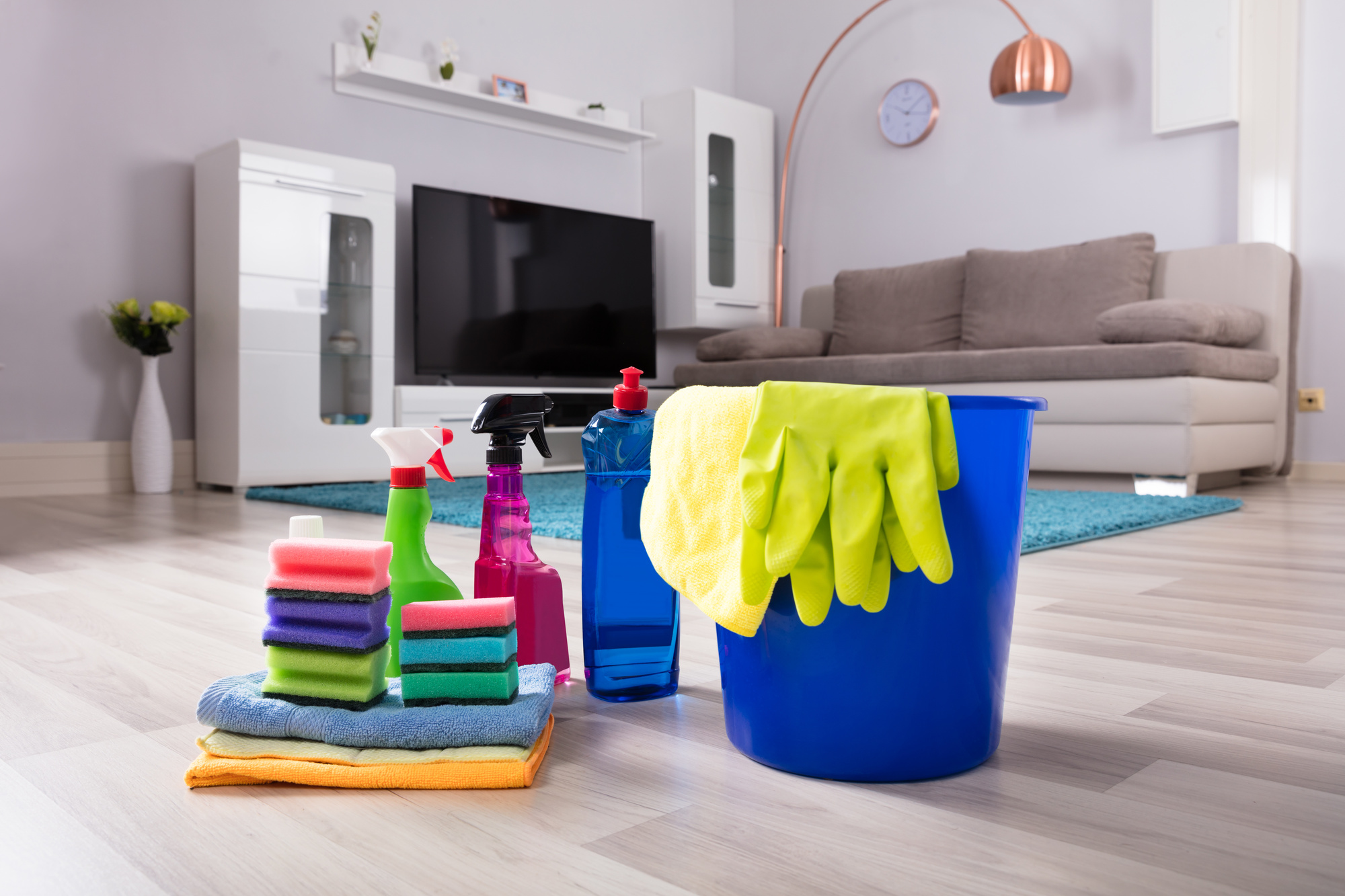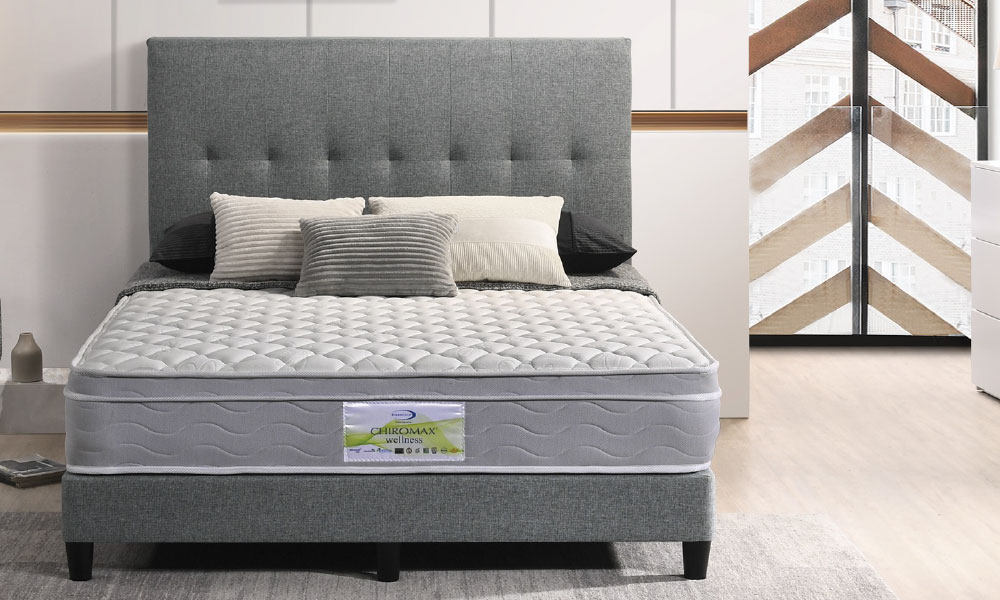If you're tired of looking at your peeling bathroom sink, it's time to take action and repair it. Peeling sinks not only look unsightly, but they can also be a breeding ground for bacteria and mold. To fix this issue, there are a few simple steps you can take. First, start by removing any loose or peeling pieces of the sink. This can be done using a putty knife or sandpaper. Once the loose pieces are removed, sand down the entire surface of the sink to create a smooth and even surface. Next, clean the sink thoroughly with a mixture of warm water and a mild detergent. This will remove any dirt or grime from the surface. Rinse the sink with clean water and dry it completely. Now it's time to repair the peeling areas. If the sink is made of porcelain, you can use a porcelain repair kit. Follow the instructions on the kit to create a smooth and even repair. For other materials, such as acrylic or fiberglass, you can use an enamel repair kit or an epoxy resin to fix the peeling areas. After the repair has dried, sand down the area again to create a smooth surface. Clean the sink once more and then apply a coat of primer. This will help the paint or finish adhere to the sink better. Finally, choose a paint or finish that is specifically designed for bathroom sinks. Apply multiple coats, following the instructions on the product, to create a durable and long-lasting finish. Once the paint or finish has dried completely, your sink should look as good as new!Peeling Bathroom Sink Repair
Stains on a bathroom sink can be frustrating and difficult to remove. But fear not, there are a few simple solutions to help you get rid of those pesky stains. For mild stains, start by mixing equal parts baking soda and water to create a paste. Apply the paste to the stained areas and let it sit for 10-15 minutes. Then, scrub the area with a soft-bristled brush and rinse with clean water. If the stains are more stubborn, you can try using a mixture of equal parts white vinegar and water. Let the solution sit on the stains for 20-30 minutes before scrubbing and rinsing with water. For tougher stains, you may need to use a commercial bathroom cleaner. Be sure to follow the instructions on the product and use caution when handling chemicals. Once the stains have been removed, make sure to thoroughly rinse the sink with clean water and dry it completely to prevent future stains from forming.How to Fix a Stained Bathroom Sink
If your bathroom sink is old and worn out, refinishing it can be a great way to give it a fresh new look without the cost of replacing it. First, start by thoroughly cleaning the sink with a mixture of warm water and a mild detergent. Rinse with clean water and dry completely. Next, use a fine-grit sandpaper to lightly sand the entire surface of the sink. This will create a rough surface for the new finish to adhere to. Clean the sink once more to remove any dust from sanding. Now it's time to apply the new finish. There are several options available, such as spray paint, epoxy resin, or a refinishing kit. Choose the option that best suits your needs and follow the instructions on the product for best results. After the finish has dried completely, your sink will have a fresh, new look that will last for years to come.Bathroom Sink Refinishing
Stains on a bathroom sink can be unsightly and difficult to remove. But with a little elbow grease, you can get rid of them and restore your sink to its former glory. If the stains are mild, you can try using a mixture of equal parts baking soda and water to create a paste. Apply the paste to the stained areas and let it sit for 10-15 minutes. Then, scrub the area with a soft-bristled brush and rinse with clean water. For tougher stains, you can use a mixture of equal parts white vinegar and water. Let the solution sit on the stains for 20-30 minutes before scrubbing and rinsing with water. If the stains are still persistent, you may need to use a commercial bathroom cleaner. Be sure to follow the instructions on the product and use caution when handling chemicals. Once the stains have been removed, make sure to thoroughly rinse the sink with clean water and dry it completely to prevent future stains from forming.Removing Stains from Bathroom Sink
If your bathroom sink is looking a little worse for wear, restoration can be a great option to bring it back to life. Start by removing any loose or peeling pieces of the sink using a putty knife or sandpaper. Once the surface is smooth, clean the sink thoroughly with warm water and a mild detergent. Rinse with clean water and dry completely. If the sink is made of porcelain, you can use a porcelain repair kit to fix any chips or cracks. For other materials, such as acrylic or fiberglass, an enamel repair kit or epoxy resin can be used. After the repair has dried, sand down the area to create a smooth surface. Clean the sink once more and then apply a coat of primer. Once the primer has dried, you can apply a new finish to restore the sink's appearance. With proper care, your restored sink will look beautiful for years to come.Bathroom Sink Restoration
If you're dealing with a peeling or stained bathroom sink, there are several DIY solutions you can try before calling in the professionals. For peeling sinks, start by removing any loose or peeling pieces with a putty knife or sandpaper. Next, sand down the entire surface of the sink to create a smooth and even surface. Clean the sink thoroughly and then repair the peeling areas using a porcelain repair kit or an enamel repair kit. For stained sinks, you can try using a mixture of baking soda and water, white vinegar and water, or a commercial bathroom cleaner. Scrub the stained areas and rinse with clean water. Remember to always thoroughly rinse and dry the sink after using any cleaning solutions.DIY Bathroom Sink Peeling and Staining Solutions
Stains and peeling on a bathroom sink can be caused by a variety of factors. Understanding the root cause can help you find the best solution to repair and prevent future damage. Peeling is often caused by exposure to harsh chemicals or abrasive cleaning products. To prevent peeling, use gentle cleaners and avoid using harsh chemicals on your sink. Stains can be caused by hard water, mold, or even certain medications. To prevent stains, regularly clean your sink and avoid letting water sit in the sink for extended periods of time. When dealing with stains and peeling, it's important to properly repair and refinish your sink to prevent further damage.Stained and Peeling Bathroom Sink: Causes and Solutions
To prevent your bathroom sink from peeling and staining, there are a few simple steps you can take. First, avoid using harsh chemicals and abrasive cleaners on your sink. Stick to gentle cleaners and avoid letting water sit in the sink for extended periods of time. Regularly clean your sink to prevent the buildup of dirt, grime, and bacteria. Wipe down the sink after each use and give it a deep clean at least once a week. If you have hard water, consider installing a water softener to prevent mineral buildup and stains on your sink.Bathroom Sink Peeling and Staining Prevention Tips
If your bathroom sink is beyond repair or you simply don't have the time or skills to fix it yourself, hiring a professional is a great option. Professional sink repair services have the expertise and tools to properly repair and refinish your sink, leaving it looking like new. They can also provide tips and recommendations for preventing future damage. When hiring a professional, be sure to do your research and choose a reputable and experienced company for the best results.Professional Bathroom Sink Repair Services
When it comes to cleaning and restoring a peeling and stained bathroom sink, there are several products on the market that can help. For peeling sinks, a porcelain repair kit or an enamel repair kit can be used to fix the damaged areas. For stained sinks, a mixture of baking soda and water, white vinegar and water, or a commercial bathroom cleaner can be effective. When refinishing a sink, be sure to choose a product specifically designed for bathroom sinks for the best results. Some options include spray paint, epoxy resin, or a refinishing kit. Always follow the instructions on the product and use caution when handling chemicals.Best Products for Cleaning and Restoring a Peeling and Stained Bathroom Sink
The Importance of a Well-Maintained Bathroom Sink

Why the Bathroom Sink is Essential in House Design
 When it comes to house design, the bathroom sink may not be the first thing that comes to mind. However, it plays a crucial role in the overall aesthetics and functionality of a bathroom. Not only is it a necessary fixture for daily hygiene routines, but it also serves as a design element that can enhance the look and feel of the space. That is why when a bathroom sink starts to peel and stain, it can significantly affect the overall appeal of the bathroom.
Bathroom Sink Peeling and Stained: The Culprits Behind It
There are a few reasons why a bathroom sink may start to peel and stain. One of the most common causes is the use of abrasive cleaners or harsh chemicals. These can strip away the protective layer of the sink, leaving it vulnerable to peeling and staining. Another culprit could be hard water. The minerals in hard water can build up on the sink's surface, causing discoloration and even etching.
When it comes to house design, the bathroom sink may not be the first thing that comes to mind. However, it plays a crucial role in the overall aesthetics and functionality of a bathroom. Not only is it a necessary fixture for daily hygiene routines, but it also serves as a design element that can enhance the look and feel of the space. That is why when a bathroom sink starts to peel and stain, it can significantly affect the overall appeal of the bathroom.
Bathroom Sink Peeling and Stained: The Culprits Behind It
There are a few reasons why a bathroom sink may start to peel and stain. One of the most common causes is the use of abrasive cleaners or harsh chemicals. These can strip away the protective layer of the sink, leaving it vulnerable to peeling and staining. Another culprit could be hard water. The minerals in hard water can build up on the sink's surface, causing discoloration and even etching.
Why Addressing the Issue is Important
 Aside from the obvious aesthetic concerns, a peeling and stained bathroom sink can also lead to more significant problems. As the protective layer wears off, the sink becomes more susceptible to scratches, chips, and cracks. This can not only be unsightly but can also compromise the sink's functionality. Additionally, if the sink is made of a porous material, the staining can penetrate deep into the surface, making it nearly impossible to clean.
How to Prevent and Fix Bathroom Sink Peeling and Staining
The best way to prevent peeling and staining of a bathroom sink is to properly maintain it. This includes using gentle cleaners, wiping it dry after each use, and regularly treating it with a protective sealant. If the damage has already been done, there are several ways to fix it. For minor peeling and staining, using a combination of baking soda and water can help remove the stains and restore the sink's shine. For more severe cases, it may be necessary to resurface or replace the sink altogether.
Aside from the obvious aesthetic concerns, a peeling and stained bathroom sink can also lead to more significant problems. As the protective layer wears off, the sink becomes more susceptible to scratches, chips, and cracks. This can not only be unsightly but can also compromise the sink's functionality. Additionally, if the sink is made of a porous material, the staining can penetrate deep into the surface, making it nearly impossible to clean.
How to Prevent and Fix Bathroom Sink Peeling and Staining
The best way to prevent peeling and staining of a bathroom sink is to properly maintain it. This includes using gentle cleaners, wiping it dry after each use, and regularly treating it with a protective sealant. If the damage has already been done, there are several ways to fix it. For minor peeling and staining, using a combination of baking soda and water can help remove the stains and restore the sink's shine. For more severe cases, it may be necessary to resurface or replace the sink altogether.
The Bottom Line
 In conclusion, a well-maintained bathroom sink is essential in house design. It not only adds to the overall appeal of the bathroom but also plays a vital role in its functionality. By understanding the causes of peeling and staining and taking proactive measures to prevent and address it, homeowners can ensure that their bathroom sink remains in pristine condition for years to come. So if you notice your bathroom sink starting to peel and stain, don't ignore it. Take action to protect this important fixture in your home.
In conclusion, a well-maintained bathroom sink is essential in house design. It not only adds to the overall appeal of the bathroom but also plays a vital role in its functionality. By understanding the causes of peeling and staining and taking proactive measures to prevent and address it, homeowners can ensure that their bathroom sink remains in pristine condition for years to come. So if you notice your bathroom sink starting to peel and stain, don't ignore it. Take action to protect this important fixture in your home.



